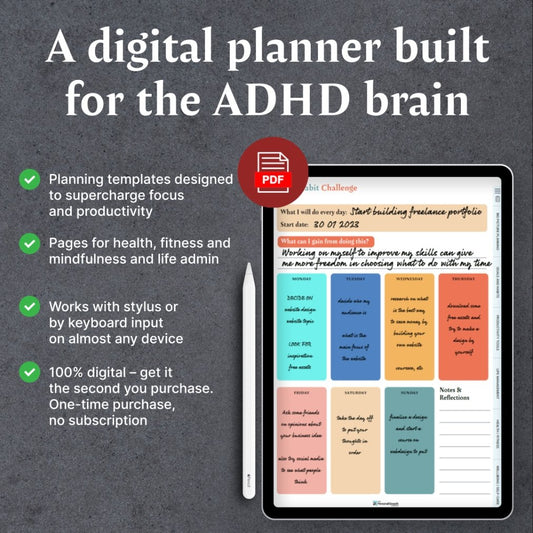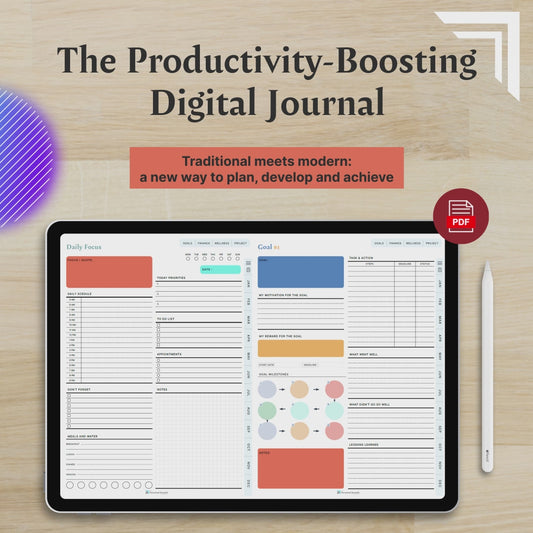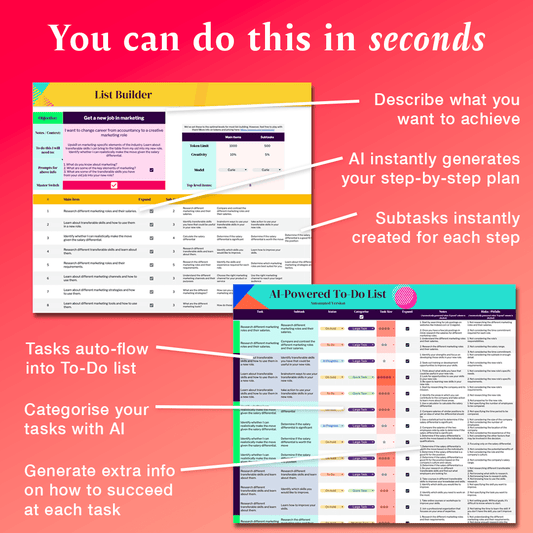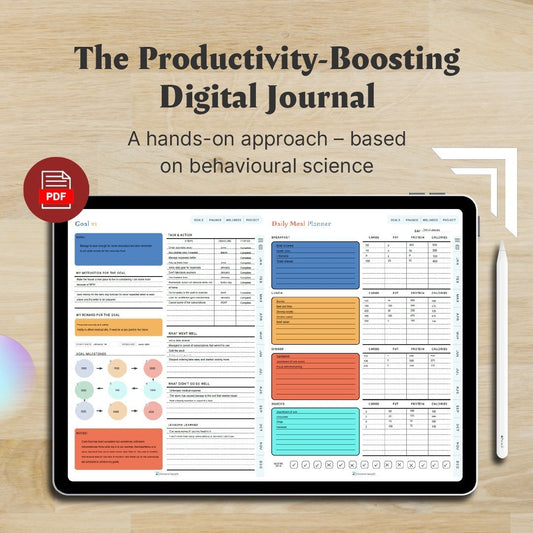You want to create content. You want to practice piano so that you can play like you did when you were a kid. You want to learn something new. You want to run. You want to start that podcast, and maybe drink more water for good measure.
You want to push against the confines of your comfort zone, take yourself off auto-pilot, and be an ever-so-slightly better version of yourself.
And yet, you just... can't.
Why is that? Well, if you happen to be a human being – as so many of our readers are – then it's probably down to the fact that you haven't yet formed the right habit.
And guess what? That's actually quite an easy thing to fix!
We say 'quite' easy, because we still needed to write a whole 3,000-word guide to accurately describe, diagnose and provide a thorough solution.
Trust us, though. The pay-off will make it well worth your time.
In this guide, we're going to dig into and distil behavioural science to uncover the reasons why we do the things we do, when we do them – then break it all down into bite-sized stages, each of which comes with a remedial action.
First, though, let's take a look at the underlying process we're addressing.
Procrastination happens when you fight against your own brain. Habits happens when you don't.
When you put something off, it's because you don't want to do it – on a conscious or unconscious level.
Habit is the opposite of that. That's when you do something, good or bad, without even realising you're doing it.
Imagine if you could make habits out of the things that will help you achieve your goals. The dream, right?
The Power Of Habit by Charles Duhigg was the Freakonomics of behavioural science; a book that catapulted the discipline into the popular psyche by making millions of people look at themselves and say: "So that's why I do the things I do!"
Duhigg himself is not a scientist (he's a former journalist, much like myself) – but his research allowed him to define a framework that's subsequently been adopted and validated by many academics in the field.
It's called the habit loop, and it consists of three elements:
- The trigger
- The behaviour
- The reward
The trigger is what sets off the existing behaviour that we'd like to alter; the behaviour is the result of that trigger, while the reward refers to the neurological after-effects of the decision we make.
To change any habit, we need to work through these step-by-step – starting by identifying the triggers that are fuelling our existing negative behaviours, then looking at the small actionable changes we can make to counter these, before finally creating a rewards system to fuel and strengthen this virtuous cycle.
And here's the thing. To do something, you need to stop not doing it
This is the theory advanced by psychologist Dr Jeremy Dean – author of the hugely popular PsyBlog – who claims that in order to ditch a negative habit, we need to form a positive new one. And this statement, like so many others in the scientific world, has a logical flipside: to add a positive new habit to our routines, we need to clear out a negative one.
For example, to go to the gym twice a week, we need to stop not going to the gym twice a week; we need to break the habit of staying in bed, not leaving our desk at lunchtime like we'd planned, or 'forgetting' our shorts.
What does that mean for you? Well, it's agonisingly simple really: to create content, you need to stop not creating content.
And what's stopping you, exactly? Well, I'm glad you asked...
If you can find your 'procrastination' triggers, you're 80% of the way there
Procrastination always begins with a single, identifiable moment in time. If we can trace back over our steps, and isolate that trigger, you'll immediately be in a position to take control of your habits and your actions.
What is it that stops you from creating content when you sit down with the intention of doing just that, or from cleaning your living room when you cleared your morning for that exact task?
What weakens your resolve to the point where you abandon your plans, and choose another course? What's the trigger that causes you to do this?
I've outlined some common ones below, but first, let's take a look at the five main categories into which triggers can be sorted:
-
Time: From simple time-based activities (getting up at 7.30am) to more complex evaluations (stopping work on one task because you've become aware of another pressing deadline), the clock plays an incredibly prominent role in habits;
-
Location: Do you always take off your jacket and throw it on to the sofa when you get in the door from work? In that case, the location – your home – is a trigger to an activity.
-
Preceding events: Actions are often grouped into sequences – if you get out of bed after you wake up, then have a cup of tea, then eat breakfast, then each action is triggered by the preceding one;
-
Emotion: Cracking your knuckles when you feel impatient, or speaking sharply to a colleague when you feel stressed? Your emotional state is acting as a trigger;
- Other people: If you've ever felt yourself getting defensive when your mother/father starts asking you invasive questions about when you're going to settle down and get married, well then you understand the 'other people' trigger. Certain people – both individuals and categories, such as 'customers' or 'suppliers' – can elicit reactions that are specific to them; these can, of course, be positive or negative.
Remember that, more often than not, a trigger will be a combination of a number of the above categories. For instance, you may get particularly snappy when you're in the car [location] with your partner [other people], and you're running late [time].
60-second action
Think of two things you did before you left the house this morning, then identify and categorise the triggers
How are these triggers manifesting themselves?
Let's get a bit more specific, and focus on the actual reasons you're stopping your from carrying out your task before you've even gotten started.
Note: I'm going to use content creation as the example for the purposes of this article. The processes and the examples below can apply much more broadly, but let's bring it to life in a way that's easily understandable.
This is best done by stating the problem and saying when, specifically, it happens – like the below examples, all of which I've encountered (and sometimes even experienced) on multiple occasions.
"I put content creation off when...
-
... I feel unmotivated, due to a sense of pointlessness about the whole exercise." Time, emotional state. You're creating content because you've read that it's the hot new trend in marketing, or because your boss has told you to – not because you really and truly understand and believe in the path it paves to success.
-
... I feel overwhelmed due to 'white-page panic'." Emotional state. The overwhelming scale of the task that leaves you wondering how you, a non-writer/editor, can possibly create an article, video, podcast, etc, out of nothing.
-
"I get about two-thirds through the piece, but don't know how to form it into something that looks right." Time, emotional state. You've got all your thoughts on paper, but what now? The sheer magnitude of that question makes it easier to just move on to something else.
-
... I'm not sure what I'm trying to even say, or what my angle is." Time, emotional state. You're unsure of where to begin, while the path to completion naturally seem fairly endless longer when you don't know what the finished piece should look like;
-
... I get self-conscious about people reading this, so I keep second-guessing every sentence I write." Other people, emotional state. This can be particularly prominent if it's a controversial angle – or one you feel has already been said a million times before;
-
... other issues keep getting in the way, all of which will take priority over content creation". Time. This is fair. After all, if you don't write this article today, the world will go on turning. The same can't be said for that software bug or logistical issue that's also demanding your attention.
I'm aware I've just listed problems without solutions here – you're going to come up with these yourself, using the approaches detailed further on.
For now, though, if you can express the triggers, you'll be in a much better place to address them. (In fact, as with so many things in life, many solutions will become astonishingly obvious the moment you define the problem.)
60-second action
Ask yourself what's stopping you from creating content. Take a minute to write down as many as you can, capturing as much detail as seems appropriate.
Don't try and change everything at once – focus your energy on tiny, precise adjustments
Say hello to micro-habits.
BJ Fogg is Director of Stanford's Persuasive Technology Lab, which is every bit as impressive as it sounds – and he's at the forefront of research and innovations in the field of behavioural science.
But he's perhaps best known for developing the concept of the micro-habit; a simple and palatable action that takes less than 60 seconds to fulfil, and can be taken at the moment a trigger is recognised. Because it's hard to talk yourself out of anything that takes such a small amount of time, the idea is that these micro-habits can help you stay more closely aligned with your long-term objectives, rather than being swayed by your short-term desires.
This will be a familiar concept to anyone who goes to the gym before work; we all know that once we're out of bed and into our training kit, the rest is quite painless (and indeed enjoyable).
But if we look at things any more broadly – contrasting the exertion of a training session with the toasty warmth of the bed or an extra hours' sleep – it will be far easier to justify the short-term decision. The solution, always, is to get up and go.
60-second action
Think of the last decision you wish you made differently. What micro-habit would have helped you to choose a different path?
Just 60 seconds of effort can put you on the path of least resistance
With the 'procrastination triggers' now identified, you need to focus on what you can do in the moments immediately following the urge to quit; winning the battle of wills while it's still a relatively fair fight.
The key to doing this is, of course, micro-habits.
Of course, not everything can be tackled in 60-second actions; they just give you a more palatable option for the moments when you need to choose between quitting or proceeding. So ask yourself: based on my obstacle, what can I do in 60 seconds to initiate a fix?
For example:
- If you're feeling overwhelmed by the white-page panic, then jot down a paragraph plan on a piece of paper that gets out the main points you want to make.
- If you're feeling stuck on a half-written piece, add in subheadings (this will clarify the structure quite significantly, and make it look more 'publishable'), or highlight one to three sections you know you need to spend a bit of time on.
- If you're worried about what readers will think, email your copy to a colleague.
- If you're worried about creating a piece of content that's actually relevant, open up answerthepublic.com and enter the topic you're writing about – you'll see the main questions people are asking about this subject, and you can use one of these questions to guide your thinking. All in just a few seconds!
60-second action
Take each of the obstacles you identified, and assign the micro-habit you'll use next time you encounter it. Keep that list visible on your desk!
If your routine is to work, it needs to be unique to you
Don't worry – I'm not going to use this section to tell you to 'mark off an hour every Monday for writing new content' or anything of the sort. Not only is that completely trite, but it's naive and unrealistic as well. Routines don't work like that.
Give them a solid foundation, a structure and a heap of fallbacks, though, and you might just be on to something.
Here are a few suggestions on how you can do that – none of which will be doable in 60 seconds, but most of which will feel a little closer to your comfort zone than writing:
- Document a content mission statement: What is your content trying to do, and how does it align with your business goals? If you don't know where to start, look at your company mission and goals, your key audiences or target markets, and the questions they have.
- Develop a content calendar: Nothing fancy – just a few iCal or Google Calendar entries, detailing what you're going to publish and when.
- Build a writing template: Create a Word Doc, or a template in a content creation tool such as GatherContent, with a pre-determined structure – for instance, the audience you're addressing, the question you want to answer, the action you'd like them to take, and a five-point paragraph plan. Filling these out will take a short few minutes, but will leave you with heaps to work with.
- Create a defined publishing workflow: If you're constantly second-guessing your quality, then knowing who (and how many people) will read and sense-check it for you is going to be invaluable to helping you focus on writing.
These are all foundational aspects of any content marketing undertaking, so it may seem a bit counter-intuitive to have them listed below the 60-second quick fixes. But let's be honest: if you were unable to commit to writing even an opening sentence, the likelihood that you'd commit the time to any of these more chunky tasks is unlikely.
The quick actions are what will give you the motivation and momentum to undertake the more substantive work – and the reason for this, we'll address next.
60-second action
Write down the next four headlines you're going to work on, and the name of the trusted person who's going to read them before they go live.
Feel the reward rush – embrace the dopamine!
When I worked in online publishing, we had a screen on the wall of our office where our real-time Google Analytics number was shown 24 hours a day. When we published a new story, we'd watch the volume of on-site users creep upwards – and when we published a hit, we'd be glued to the screen as it shot into four-figure digits, and beyond.
Not only did this satisfy our creative desire to know that our articles were being read, but it also helped us to create a direct, cause-and-effect link between our behaviour and our performance.
This made us feel absolutely great about ourselves, and this feeling in turn drove us to repeat our successes, day after day.
This is all down to dopamine – a neurotransmitter that's released by our bodies when we feel rewarded by an external stimulus (from a delicious cocktail to an Instagram like, and from a compliment to a Hollywood happy ending).
We're completely hooked on it, and that's why we keep going back to seek out experiences we know to provide us with pleasure.
Instead of waiting for long-term improvement, we're enjoying the thrill of quicker returns – and that keeps us on track
To harness this powerful function, it's crucial that we understand the link between the cause and the outcome; that is, we make ourselves aware of the good feelings associated with having our content consumed and complimented.
Let's use the example of content marketing again. Performance can be measured in a few different ways, including metrics such as:
- Pageviews;
- Unique users;
- New leads;
- Conversion rate;
- Shares;
- Sales;
- Views/listens;
- Time spent on page;
- Article comments;
- Social engagement.
As well as softer measurables, such as:
- Positive feedback from colleagues;
- Positive feedback from your network (LinkedIn, etc);
- Your own sense of satisfaction about the finished product;
- The sentiment of article comments – one response saying 'thanks for this!' can be worth hundreds of page views.
You'll be focusing on one of these measurables above the others, depending on the objectives of your campaign.
But on top of being a marketer, you're also a human being – and exposing yourself to a range of measures that show you the impact you're having will help you replicate that success over and over.
This same logic can be applied to anything else – running, reading, interpersonal relationships, you name it. Some are easier to measure than others, but all boast quick wins that you can list and revel in... so long as you know what to look for.
60-second action
List five quick wins for the habit you want to adopt. Consider how you'll be able to use them to 'gamify' your own behaviour – and feel good in the short-term as well as the long run.
Create the space to succeed
Despite breaking it all down into 60-second actions, there's a lot of information contained on this page – so don't feel overwhelmed, and absolutely don't try to tick every item off in a single attempt.
It's important that you give yourself the time and space to succeed, both on a macro level (implementing a better overall way of working) and a micro level (working on each individual piece of content).
Here's what I mean by that:
Macro level
- It sounds obvious, but don't attempt to implement every single measure listed here in one go. Not only will it divide and detract from the quality of your efforts, but it will also make you feel like you've failed when you don't achieve immediate success.
- Following a set approach will cut out a lot of messing, and will help you get to where you need to be a whole lot quicker. But it's a process; all you can do today is begin it.
- Keep revisiting the process, keep adding new actions, and try to understand the science of habit-forming as best you can so that you can make the changes that will work best for you.
Micro level
- Try to focus on just writing when you're writing. If possible, do your research in advance, then write in a distraction-free environment (such as Hubspot's Zen editor or an app like Place To Write).
- Use a pen and paper to note the questions that arise as you go through the piece. Not only will this keep you focused on writing, but it will teach you a lot about what you know and what you don't – not to mention the questions your reader may have while reading.
- If you use a Mac, switch to full screen mode and unplug any second screen that you use; and if you're really determined, close all other open apps and put your computer in Do Not Disturb mode.
60-second action
Set a reminder in your calendar to revisit this article in four weeks' time. Scan through the headings to note what's improved and what still needs work.
Will each of these steps be feasible every time you sit down to write? No, of course not! But even making a start will serve as a powerful message to yourself that you mean business here.
And I promise you. It really does get easier every single time.
Some resources to check out
Books:
-
Thinking Fast And Slow – Daniel Kahnemann
-
The Power Of Habit – Charles Duhigg
-
The Coaching Habit – Michael Bungay Stanier
-
Making Habits, Breaking Habits – Dr Jeremy Dean
-
Mindsight: The New Science Of Personal Transformation – Dr Dan Siegel
Blogs/websites:





